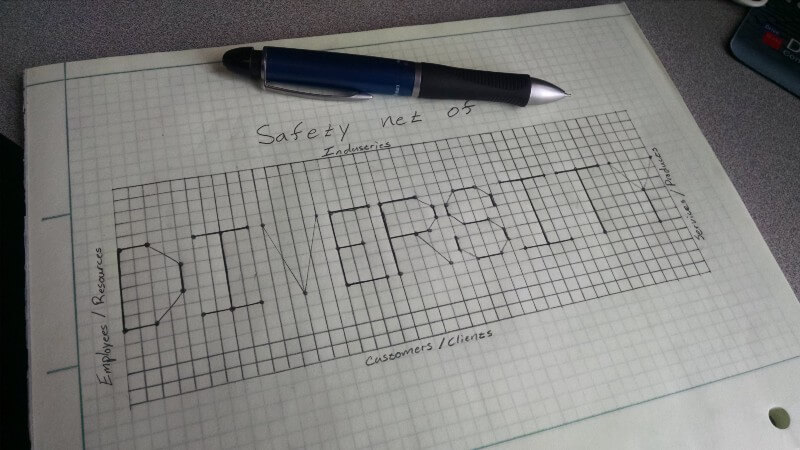Building a Sustainable Business with Mission, Clarity, & Flexibility
Nov 18, 2015 | 2 min read

The term sustainable is generally focused on the environment. It seems this is a drastic under-utilization of the very versatile word. The Merriam-Webster dictionary defines sustainability in three ways:
1. Able to be used without being completely used up or destroyed
2. Involving methods that do not completely use up or destroy natural resources
3. Able to last or continue for a long time
The first two definitions hint at environmental sustainability or conservation of resources. These are great and get a lot of attention, but what about the broad application possible with the third definition?
Consider sustainable business. Not recycling of office paper and replacing disposable cups with ceramic mugs, but sustainable business practices. Business practices which enable businesses to last or continue for a long time. Sure recycling and reduction initiatives can contribute to a business being sustainable, but it’s unlikely that reducing paper consumption, or even going net-zero waste will help pay the bills when we’re riding the downward slope of the economic wave.
Diversification is a great example supporting business sustainability.
Ideally business diversification has multiple layers. Diversification of clients, services, products, industries, employees, vendors, etc… all contribute to an overlapping mesh of sustainability. It’s easy to be enamored with the current cash cow, but taking advantage of a temporary spike in resources or a booming industry with little regard for what your business looks like in their absence can be dangerous.
Having a clear and meaningful mission is also helpful in the development of a lasting organization.
If your teammates don’t have a clear understanding of the organizational goals, they will likely get caught in the trap of blindly following the direction of bureaucratic systems placed around them. The team also needs to understand how their daily activities contribute to the mission. L. David Marquet does a great job of demonstrating this in his book Turn the Ship Around!.
He specifically discusses experiences where his team (a submarine crew) lost focus on the goal and instead invested in minimizing mistakes and avoiding problems. He later states “Focusing on avoiding mistakes takes our focus away from becoming truly exceptional.” Want a lasting business? Connect your team with a meaningful mission.
Be flexible.
Change can be intimidating, especially if your industry is changing but your business is not. Being sustainable as a business will occasionally require a change or adaptation in what you do or how/where you serve. These changes may be a result of competition, regulation, demand, resource availability, etc… Regardless of the reason, we must be willing to make calculated adjustments.
The petroleum titan John D. Rockefeller demonstrated this when he shifted the focus of his business (Standard Oil) from primarily kerosene to gasoline. He recognized that one way or another Nikola Tesla (AC) or Thomas Edison (DC) were going to be displacing demand for kerosene (kerosene lamp) with their modern electricity (incandescent light bulb).
Rockefeller took his core competency of refining oil and adjusted his process to capture gasoline in addition to kerosene. While Standard Oil was forced to dissolve in 1911, it’s resulting pieces have been successful for over 100 years. (Ironically, those constituents have started to merge again…)
Clarity can also be gained by observing business practices which are not sustainable.
For example, my father and grandfather both retired from a large automotive manufacturer after ~30 years of service and have been collecting their promised pension ever since. I won’t get into the math, but will say my grandfather has been collecting a paycheck as a retiree longer than he did as an employee. I say good for both of them… but it’s not a sustainable option.
You may question the impact of a few pensions on a company generating ~$160B annually. It’s a drop in the bucket, but scale this up to buyouts and early retirements of 30,000 employees which are not far beyond mid-life and things become a little strenuous.
Now consider the rising costs of health care (also funded by the company) and the increasing expected life span and all of a sudden a business becomes very volatile. A small hiccup in consumer confidence and we have bailouts. To the credit of those making the decisions, I’m not sure I could have done better. Without doubt, offering these benefits seemed to be the best choice at the time. The model just wasn’t able to withstand the downturn of 2008 & 2009.
While there’s no one way to guarantee a business will be sustainable, it’s crucial to consider the impact of scaling current processes and prolonging current practices. Building models around this premise and playing “what-if” scenarios will likely uncover risks and opportunities. Uncovering these risks and opportunities is the easy part… Responding to them is key to developing a sustainable business.
Written By: Ryan Noble, Student of Life & Product Development Engineer | Ryan is a seasoned mechanical engineer with substantial experience in machine and product development. He’s a continual learner and teacher/coach, welcoming constructive criticism to satisfy an insatiable desire for excellence.
Written By:

Ryan Noble
Team Lead – Product and Machine Design | CAE
DISHER Newsletter
Sign up to receive articles and insights, delivered monthly.
Schedule a no-committment project call
Reach out to discuss your project to find out if DISHER could be a good fit for you.

